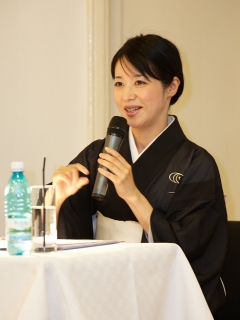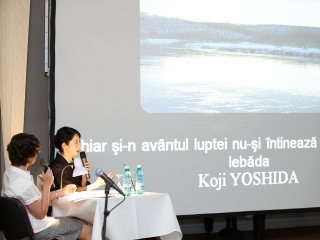Haiku poet Madoka Mayuzumi delivered a special lecture at the Fifteenth Symposium on Japanese Language Education in Europe , held in late August 2010 at the University of Bucharest in Romania. Mayuzumi, appointed by Jap an’s Agency of Cultural Affairs as a special advisor for cultural exchange, was invited to speak by the Tokyo Foundation, which provided assistance for the symposium and which has also been supporting Japanese language education at the University of Bucharest for many years through the Nippon Foundation Fund for Japanese Language Education Program .
Prior to the symposium, Mayuzumi also delivered a lecture for members of the general public at the university entitled “Haiku: The Heart of Japan in 17 Syllables.” Over 100 Romanian students, cultural figures, and haiku enthusiasts attended the lecture and poetry reading. She also discussed haiku and Japanese culture with a smaller group following the lecture.
* * *
A haiku is the world’s shortest poem consisting of just 17 syllables. Despite its succinct form, it contains the essence of Japanese people’s aesthetics, view of nature, philosophy, thought, and sentiments. As a rule, haiku must have a kigo (a word connoting a season) and are rendered in three lines of 5, 7, and 5 syllables each. The kigo is a reflection of the Japanese people’s sensitivity to the changing seasons, our love of nature, and our respect for form. These qualities are seen not just in haiku but in many other manifestations of Japan’s traditional culture. Just what exactly is a haiku, and what is its place in modern Japanese society? Let me explain with references to things that are close to the hearts of Japanese people.
Encounter with Haiku

I first discovered the rich world of haiku when I read a poem by Hisajo Sugita, who was active in the first half of the twentieth century: Hanagoromo / nuguya matuwaru / himo iroiro . This can be translated as: “Unfastening the cords / Around my spring kimono / One by one.” Hanagoromo is the kimono women traditionally wore to go cherry-blossom viewing.
The Japanese love cherry blossoms; in the past, women used to order a new kimono early each spring to wear to blossom-viewing events. These beautiful kimonos were called hanagoromo .
The haiku depicts a woman who has returned from such an event is now disrobing in her room at night. The many layers of a hanagoromo , including undergarments, are held together by various cords. She has removed the cords one by one, and the kimono is now scattered around her feet, still warm from being next to her skin. She stands unfettered in her room, outside of which stand cherry trees in full bloom.
The poem elegantly captures the sensuous beauty of this scene, but there is much more that Hisajo tried to convey. She was born in 1890, a time when publishing poems as a form of self-expression was not considered proper for a woman, and she was harshly criticized by her contemporaries. Her marriage, too, was unhappy, and her last days were spent in a mental hospital. She was a highly talented poet yet did not publish a single collection of her works during her lifetime. The cords around the woman’s feet in the haiku are a metaphor for the various social stigmas that kept women bound in her day. The true artistry of this poem is that while it is an expression of Hisajo’s inner sorrow and torment—which was no doubt shared by many women of her time—such sentiments are not conveyed bluntly but transformed into something more refined and beautiful. This, for me, is the true appeal of haiku.
By avoiding direct emotional expression, the author is cleansed of and is able to transcend those emotions. Our modern society has become full of words and explanations, so it was with great surprise and joy that I chanced upon such a condensed, refined, and simple poetic form. That is how I developed a deep love for haiku.
History of Haiku
The haiku was born in the late fifteenth century. It was originally part of a much longer poetic form called renga , which literally means “linked verse.” Renga were written by two or more persons by linking stanzas comprising lines of 5, 7, 5, 7, and 7 syllables each. Haiku are essentially the first three lines of this older form. Initially called hokku (literally, “first verse”), the haiku was elevated into a refined poetic style in the seventeenth century by Matsuo Basho and renamed haiku by Shiki Masaoka at the end of the nineteenth century.
Today, haiku are written in many different languages around the world. European Council President Herman Von Rompuy is a noted lover and writer of haiku who just recently published a collection of his poems. Enthusiasts in France include former President Jacques Chirac and Prime Minister Dominique de Villepin.
The haiku-writing population in Japan is said to number 8 million to 10 million. Innumerable submissions are made each week to daily newspapers, weeklies, and other magazines that feature sections for haiku and similar short verses written by readers. These are not works by professional poets but by members of the general public. In a world where poetry as a literary art form is now waning—even new editions of Shakespeare’s sonnets have print runs of only around 2,000 copies—the love of haiku, tanka , senryu , and other short poetic forms among the Japanese people still endures.
Haiku have also had a broad influence on other poetic genres and in many other countries. Soviet Russian film director Sergei Eisenstein is said to have gained hints for his theory of montage in cinema from the haiku form. And John Lennon reportedly drew inspiration from haiku when he wrote his hit song, “Imagine.”
Haiku Conventions

Haiku, as a rule, have three lines of 5, 7, and 5 syllables each and contains a kigo , which indicates a season. This emphasis on a seasonal element is probably an outgrowth of the Japanese people’s sensitivity to nature. Each country has its own areas of scenic beauty and a unique way of relating to nature. The Japanese approach is to become completely one with it.
For example, popular seasonal pastimes in Japan include cherry-blossom viewing, firefly viewing, and autumn-foliage viewing. These activities are referred to as gari in Japanese, which literally means to “hunt”; the purpose of these events is, of course, not to take home cherry or maple branches as spoils. The reference to gari indicates that you are not merely looking at beautiful scenes of nature from afar but stepping into their midst and appreciating them up close and on their own terms.
There are many seasonal kigo to describe mountains. In the spring, for instance, the hills are said to be “smiling.” This refers to the warm, gentle stirrings of life, like the appearance of shooting buds and blossoming flowers and the chirping of birds. In the summer, mountains “trickle”; with their new coat of green leaves, trees are so full of life that water seems to ooze from them.
In the fall, the mountains turn red and golden. Maples don a coat of bright red leaves, while other trees turn yellow or brown. This is as if the mountains have “adorned” themselves with blush makeup. When the trees drop their leaves in the winter and lie quietly, the mountains are said to be “sleeping.” By thus personifying nature, a very close affinity with it is created.
The “smiling” mountain in the spring seems to share with us the joy of having endured and overcome the cold, harsh winter. The Japanese people have traditionally been heavily influenced by changes in the seasons and have incorporated those changes in their lifestyles. In early spring, we await the first blossoming of flowers, and in the early summer we enjoy viewing the dance of fireflies in the evening. As the summer heat intensifies, we hang wind chimes by the window and listen to the breeze. Autumn is the time to appreciate the full moon, the fall colors, and the song of crickets. And winter brings pure, white snow. While appreciation of such seasonal changes has diminished in Tokyo and other modern cities, it is still an enduring part of everyday life in older parts of the country, like the ancient capital of Kyoto.
The kigo evolved from cultivating such close ties with nature. Seasons always come and go, even during times of social upheaval like warfare. The full moon appears each month, and cherries always blossom in the spring. The Japanese people have lived with these seasonal changes and shared the joys, sorrows, and concerns that the changes bring. The kigo encapsulates all these sentiments, our happiness, our pain, our tears, and even our values and aesthetics. It is the secret behind the haiku’s ability to make profound statements with just 17 sounds.
The 5-7-5 syllable format also gives haiku a distinctive rhythm. Traditional manifestations of Japanese culture, such as the noh theater, flower arrangement, and tea ceremony, all make use of conventionalized forms. Many people comment that haiku is already restricted by being so short and having fixed syllables and wonder why there is a need for a kigo . Ironically, it is the rigid structure and seasonal requirement that give poets the freedom to let their imagination run free.
Writing a poem can be likened to an Olympic event. One of the best-known Romanian athletes is Nadia Comaneci. If she stepped outside the 12-meter by 12-meter performing area in the floor exercise, for instance, points would have been deducted from her score. If, on the other hand, she limited her movements to the center of the mat to avoid a penalty, her score would have been low. The highest points are given to exercises that use the entire floor, including along the perimeter. A gymnast’s foot landing firmly just inside the perimeter after a flip along the diagonal is breathtaking and beautiful because of the tension created by the danger of falling out of bounds.
A haiku is like the 12-meter-square floor. It is because we must operate within the confines of a narrow, constricting poetic structure that we are compelled to give depth to our words. We must pare down and strip away all superfluous elements until all we have left is the bare essence; it is the tension created by the need to accommodate a prescribed shape that enhances the reverberating beauty of a poem.
Haiku as a Form of Greeting

Haiku is sometimes described as a form of greeting, much like “hello,” “goodbye,” and “thank you.” A haiku is dedicated to the people—as well as birds, flowers, and other forms of life—that we happen to meet as our contemporaries. A haiku about cherry blossoms is a thank-you letter for having endured the long, harsh winter to delight us in the spring. In so doing, the fleeting pleasures provided by the sight of a cherry tree in full bloom can be eternalized in verse. Composing a haiku is an act of reciprocation for the wonders and delights that nature provides. The cherry blossoms that Basho wrote about three centuries ago are still as radiant as ever in the vase of his haiku.
Between the Lines
The Japanese people are sometimes thought of as being vague and unable to say “no.” But this is not entirely accurate. It is not that we cannot say “no” but that we do not need to say it. It is simply hinted, and the hint is understood. People can read “between the lines” of short utterances and guess what the other person is trying to say. Japanese culture is thus a “sympathetic” one, and the ultimate manifestation of this phenomenon is the haiku. The succinct form of the haiku leaves plenty of space for what was left unsaid. There is an eloquence to this silence, and it is this quality that characterizes many aspects of Japanese culture.
Movement in the noh theater, for example, is regarded as being quite subdued, but, again, it is the stripping away of all nonessential motion that gives richness and depth to the intervals between each stage movement. Perhaps the same can also be said of food. A chef that studied in France noted that if French cuisine uses 10 parts seasoning, Japanese dishes only use 5. A deliberate choice is made not to add too many flavors. This is not to say that Japanese food is bland; great effort is made in preparing the ingredients and adding “hidden” seasoning, but this is done in subtle ways that are not obvious. It is up to the diner to complete the gastronomical experience.
Similarly, in the Japanese art of flower arrangement, flowers do not fill up the entire space. The Sogetsu school of ikebana , where I used to study, utilizes the concepts of shin , soe , and hikae to prescribe the positions and angles of the stems. There is a broad opening between soe (second longest) and hikae (short) stems, which forms an integral part of the floral arrangement. In fact, one ikebana artist noted that the focus of attention when creating an arrangement was not the flowers themselves but the space between them.
I feel the same way when writing a haiku. While I am weaving together words to create a poem, I am at the same time weaving the spaces between them in my tapestry. And to gain a full appreciation of Japanese culture, it is essential that you not only read between the lines but also smell and feel the spaces and pauses, filling in the missing pieces on your own. Readers must draw from their own experience to reproduce the epiphany felt by the author in the spaces that have been left unfilled.
A haiku is thus a joint undertaking between the author and reader. It is often said that a haiku cannot be written that is richer or deeper than the person creating them. In a similar vein, a reader whose life experiences are limited will be unable to share in the richness or depth of the sentiments expressed.
It is between the lines—in the words that have been left unsaid—that the haiku communicates the poet’s deepest sentiments and thoughts. In the words of haiku master Basho, “What is left after everything there is to say has been said?” Words alone cannot describe the fullness of the human experience.
The Spirit of Haiku
Composing a haiku means giving a voice to the “other” appearing before our eyes and taking a slice of Earth’s life. By so doing, we ourselves tap into the cosmic source of life and create a synchronicity and fraternity with other living beings. This is also a process of self-discovery, a journey to the depths of one’s own hearts. It is through the “other” that we discover things about ourselves.
Basho used the phrase karo tosen to describe haiku. Karo means a brazier (stove) in the summer, and tosen is a fan in the winter. In other words, haiku may serve no practical use in our present reality but are nonetheless of great importance. People do not need haiku to live, nor will haiku fill hungry stomachs. But to lead a richer life, haiku—as well as other forms of culture and art—can be of paramount importance.
Culture and art may not be practical, but modern society has lost so much in its relentless pursuit of the practical lifestyle. This is something that I believe needs to be reexamined.
By embracing the world that remains unexpressed, the haiku attains unity with the fullness of the natural world. Through haiku, one can become one with a flowering violet, for example; you come to respect all forms of life, both human and otherwise. I am convinced that such an appreciation of the preciousness of life—which can perhaps be called the spirit of haiku—can help us find solutions to conflicts between peoples, environmental degradation, and many other problems besetting modern society.
